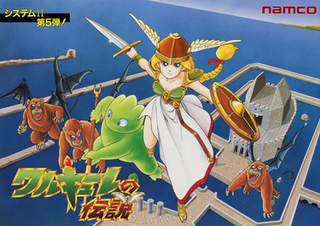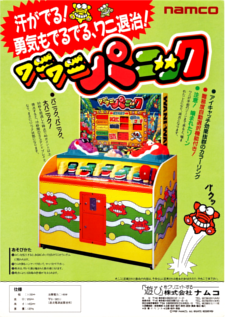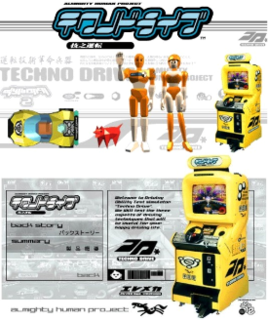
Namco Limited was a Japanese multinational video game and entertainment company, headquartered in Ōta, Tokyo. It held several international branches, including Namco America in Santa Clara, California, Namco Europe in London, Namco Taiwan in Kaohsiung, and Shanghai Namco in mainland China.

Whac-A-Mole is an arcade game, originally known as Mogura Taiji or Mogura Tataki in Japan. A typical Whac-A-Mole machine consists of a waist-level cabinet with a play area and display screen, and a large, soft, black mallet. Five holes in the play area top are filled with small, plastic, cartoonish moles, which pop up at random. Points are scored by whacking each mole as it appears. The faster the reaction, the higher the score.

Banpresto Co., Ltd. was a Japanese video game developer and publisher headquartered in Shinagawa, Tokyo. It had a branch in Hong Kong named Banpresto H.K., which was headquartered in the New Territories. Banpresto was a partly-owned subsidiary of toymaker Bandai from 1989 to 2006, and a wholly-owned subsidiary of Bandai Namco Holdings from 2006 to 2008. In addition to video games, Banpresto produced toys, keyrings, apparel, and plastic models.

The Tower of Druaga is a 1984 arcade action role-playing maze game developed and published in Japan by Namco. Controlling the golden-armored knight Gilgamesh, the player is tasked with scaling 60 floors of the titular tower in an effort to rescue the maiden Ki from Druaga, a demon with eight arms and four legs, who plans to use an artifact known as the Blue Crystal Rod to enslave all of mankind. It ran on the Namco Super Pac-Man arcade hardware, modified with a horizontal-scrolling video system used in Mappy.

Gaplus is a 1984 fixed shooter arcade game developed and released by Namco. It is the third game in the Galaxian series, serving as a direct sequel to Galaga (1981). In North America, a modification kit was later released to change the name to Galaga 3, possibly to reflect its position in the series. It was the only game other than Phozon to run on the Namco Phozon hardware. A contemporary home port for the Commodore 64 was released in 1988. A "demastered" version of the game was included in Namco Museum Archives Vol. 2 as a bonus title.

Galaxian3: Project Dragoon is a 3D rail shooter video game developed and published by Namco. It was originally a theme park attraction designed for the International Garden and Greenery Exposition in Japan, and was later released as an arcade game in 1992. The game involves players controlling a starship named the Dragoon in its mission to destroy Cannon Seed, a superweapon set to destroy what is left of the human race.

Bandai Namco Holdings Inc., also known as the Bandai Namco Group and generally Bandai Namco, is a Japanese holding company headquartered in Minato, Tokyo, formed from the merger of Bandai and Namco on September 29, 2005. The company specializes in toys, video games, arcades, anime, and amusement parks.

Valkyrie no Densetsu is a 1989 action-adventure role-playing arcade game developed and published in Japan by Namco. It is a follow-up to the Family Computer game Valkyrie no Bōken (1986). Players control the warrior maiden Valkyrie and her lizard-like companion Kurino Xandra as they set out to drop a mythical item called the Golden Seed into the Northern Fountain to replenish the dying crop fields of Xandra Land. Gameplay involves defeating enemies and collecting gold to purchase magical spells and weapons in shops.

Xevious 3D/G is a 1996 vertically scrolling shooter arcade game developed and published by Namco. The eight entry in the Xevious series, it combines 2D-based gameplay with 3D gouraud-shaded polygon graphics. Players control the Solvalou starship in its mission to destroy a rogue supercomputer named GAMP and the Xevian Forces, using two basic weapon types - an air zapper to destroy air targets, and a blaster bomb to destroy ground targets. The game also features destructive power-ups, new bosses, and two player simultaneous play.

Alpine Racer is a racing sports video game developed and published by Namco for arcades. It had a limited release in December 1994, followed by a wide release in July 1995. It ran on the Namco System 22 arcade hardware.

Gator Panic is a redemption arcade game released in 1988 by Namco. The game plays very much like Whac-A-Mole, but features alligators coming out of the cabinet horizontally instead of moles coming out vertically.

Bandai Namco Studios Inc. is a Japanese video game developer headquartered in Kōtō, Tokyo. Its offices in Malaysia and Singapore, Bandai Namco Studio Malaysia and Bandai Namco Studios Singapore, are based out of Selangor, Malaysia and Infinite Studios, Singapore respectively. Bandai Namco Studios is a subsidiary of Bandai Namco Entertainment, which itself is a subsidiary of Bandai Namco Holdings. The company works under its parent company as a keiretsu; Bandai Namco Studios creates video games for home consoles, handheld systems, mobile devices and arcade hardware, while Bandai Namco Entertainment handles the managing, marketing and publishing of these products.

Namco Community Magazine NG is a video game magazine. It was distributed in Japan by Namco, quarterly from 1983 to 1986, and bimonthly from 1986 to 1993. Based on a suggestion made by company president Masaya Nakamura, its content relates to Namco video games and progressed to crafts, developer interviews, fan mail, and two manga series illustrated by Hiroshi Fuji.
VR-1 is a virtual reality amusement park attraction released by Sega. Installed publicly for the first time in July 1994 at the opening of the original Joypolis indoor theme park, Yokohama Joypolis, it represented the culmination of Sega's Japanese AM teams and the Virtuality Group's collaborative developments in the field of VR. In 1996 and 1997, respectively, it was also installed at SegaWorld London and Sega World Sydney.

Techno Drive is a 1998 driving simulator arcade game developed and published by Namco in Japan. It is known for its unique graphical interface that uses fluorescent colors choices and flat shading. Players control a racecar throughout a variety of different minigames, each testing their skill and reaction time. Minigames include drifting along corners, avoiding collision with other vehicles, and driving with a bowl of liquid attached to the rear of the car. The game was designed for the Namco System 12, an arcade board based on raw PlayStation hardware.
The Namco 50th Anniversary was a celebration of the Japanese video game developer and publisher Namco, commemorating its establishment in 1955. Beginning on June 1, 2004, the anniversary included video games, toys, clothing, and events relating to Namco and its games. Games published under the 50th Anniversary label include Pac-Pix, Mr. Driller Drill Spirits, NamCollection, and Namco Museum 50th Anniversary. The Namco 50th Anniversary ended on March 31, 2006, when Namco was dissolved and merged into Namco Bandai Games.

Namco Funscape, formally known as Namco Funscape County Hall, was a Namco amusement arcade located on the ground to basement levels of County Hall, Westminster, London. Originally opened as Namco Station in August 1997, it operated as one of the capital's leading family and corporate entertainment centres for 25 years, closing permanently in August 2021 due to redevelopment plans blocking a lease renewal.

















